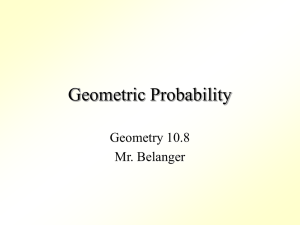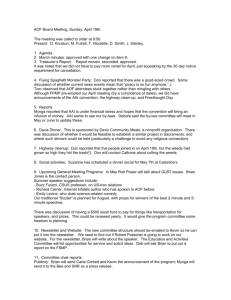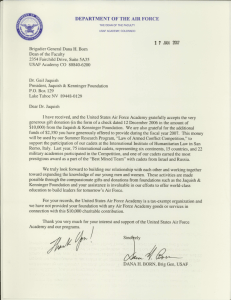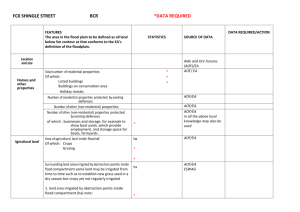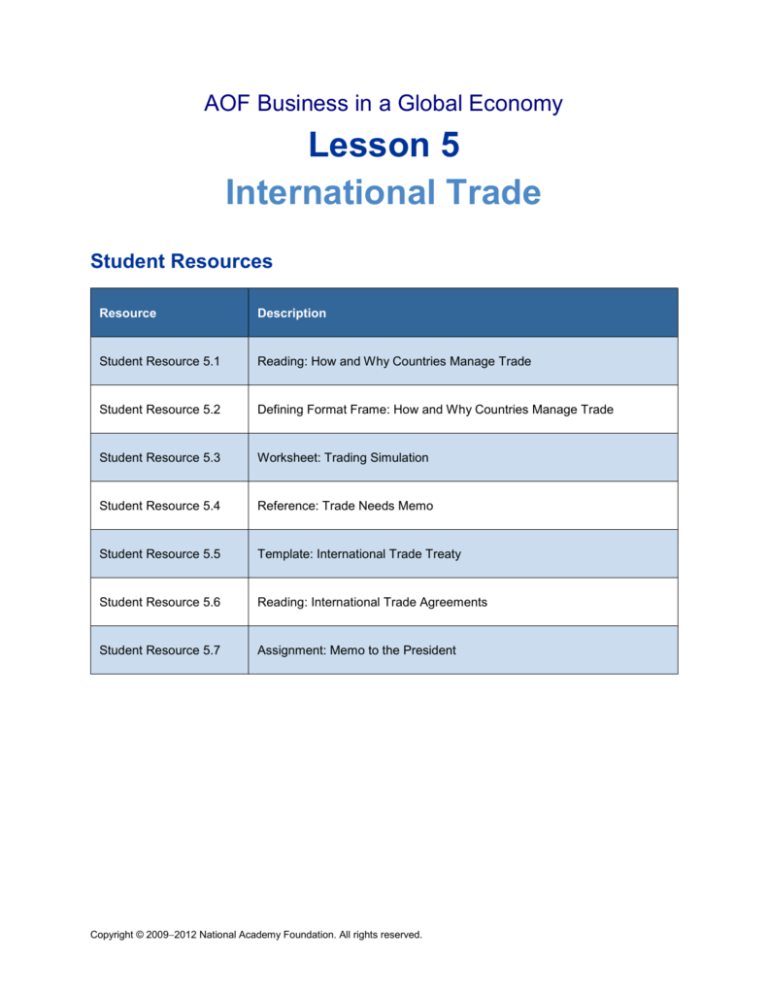
AOF Business in a Global Economy
Lesson 5
International Trade
Student Resources
Resource
Description
Student Resource 5.1
Reading: How and Why Countries Manage Trade
Student Resource 5.2
Defining Format Frame: How and Why Countries Manage Trade
Student Resource 5.3
Worksheet: Trading Simulation
Student Resource 5.4
Reference: Trade Needs Memo
Student Resource 5.5
Template: International Trade Treaty
Student Resource 5.6
Reading: International Trade Agreements
Student Resource 5.7
Assignment: Memo to the President
Copyright © 20092012 National Academy Foundation. All rights reserved.
AOF Business in a Global Economy
Lesson 5 International Trade
Student Resource 5.1
Reading: How and Why Countries Manage Trade
Anytime you purchase something, you have to make choices. Even buying a tube of toothpaste requires
choosing from different brands, different prices, and different features.
But have you ever thought about where the products you buy are made? Are they local, or do they come
from thousands of miles away, shipped on a huge ship, truck, or train and then on to the store you
brought them from? Perhaps the products you buy consist of parts or ingredients made in one country
and assembled in another. Chances are good that the governments of the countries the products come
from have encouraged their export in some way.
Trade is global, with trillions of dollars’ worth of goods and services moving between businesses from one
country to another. But why do governments seek to manage international trade, and what are the risks
and benefits of managing trade?
Copyright © 20092012 National Academy Foundation. All rights reserved.
AOF Business in a Global Economy
Lesson 5 International Trade
Trade is the exchange of goods or services between two or more parties. It has existed in some form
since the beginning of human history. You have probably been trading for much of your life. Even as a kid
you might have swapped a peanut butter and jelly sandwich for a turkey one.
Trading one thing for another, like one sandwich for another, is called bartering. Bartering is how people
exchanged things before money existed. Each side had to agree on how much of one thing was equal in
value to another to make the trade fair, meaning it was attractive and acceptable to both parties. For
instance, if the blacksmith wanted to trade milk for horseshoes, he and the farmer would have to agree on
how much milk was equal in value to how many horseshoes.
Although the principles of trade are basically similar today, there are some big differences between
modern trade and bartering. Now, of course, we use money. We buy or sell items or services rather than
barter for them. Also, back in olden times, most deals occurred face-to-face. Now, in a global market with
modern modes of shipping and communication, a business in one country can send or receive goods
from another company thousands of miles away without the people making the trade actually meeting in
person.
Copyright © 20092012 National Academy Foundation. All rights reserved.
AOF Business in a Global Economy
Lesson 5 International Trade
Despite the many benefits of international trade, almost all governments intervene in matters concerning
imports and exports. Trade policy can encourage or discourage certain industries. Which industries a
government chooses to encourage depends on natural resources, location, and political and economic
goals.
Governments influence trade in many different ways. They may enter into bilateral or multi-lateral trade
agreements (also called trade treaties or pacts).They may undertake protectionist measures or limit
imports through tariffs and quotas. A tariff is a tax on businesses importing a specific product. For
instance, the US government collects a 2.5% tariff on imported cars, which tends to make the foreign cars
more expensive than similar domestically made cars. The tariff is intended to “protect” the domestic auto
industry. A quota is a limit on how much of an item is allowed to be imported. Placing a quota on a
product makes it scarcer and usually increases its price.
Governments regulate trade for a variety of reasons. Poorer countries use tariffs as a major revenue
source, easier to collect than other taxes, or to protect industries they think are at risk. Sometimes a
government restricts trade with another country for political reasons; a ban on imports from a specific
country (and/or exports to it) is called an embargo.
To increase the exports by a specific industry, governments sometimes grant export subsidies, payments
to certain businesses encouraging them to export. This may also cause them to sell their products
overseas at a lower price, though that is by no means assured.
Copyright © 20092012 National Academy Foundation. All rights reserved.
AOF Business in a Global Economy
Lesson 5 International Trade
Every country’s firms have to use the factors of production, which are the resource inputs that enable
firms to produce goods and services. The availability of factors of production helps determine which items
a country’s firms can efficiently produce and then trade.
The factors of production include land (defined to include natural resources such as water, soil, and
minerals). Countries with fertile soil and abundant crops may provide domestic farmers the ability to
produce surplus crops which can traded for other goods. Some countries, such as Saudi Arabia, have a
much larger supply of oil than its citizens can use, and therefore trade oil for income.
Labor is the human effort used in production. It includes the attributes of employees that are necessary to
produce particular goods and services competitively, such as technical skills and knowledge. Some
countries have become hubs for firms that specialize in providing efficient labor, such as India with its call
centers or China with its manufacturing.
Capital refers to human-made goods that are retained over time and used in producing other goods and
services. Capital includes machines, tools, buildings, inventories of materials and components, and the
infrastructure used to produce other goods or services. Capital depreciates, or loses value, over time, but
is not used up in production in the way electricity or raw materials are. Government policies can help firms
obtain capital.
Copyright © 20092012 National Academy Foundation. All rights reserved.
AOF Business in a Global Economy
Lesson 5 International Trade
Specialization occurs when an industry in a certain country is able to produce a particular good or service
more efficiently than it can be produced in any other place. The combination of both government policies;
the country’s land, labor, and capital; and international competition among businesses shapes the pattern
of specialization—that is, which countries specialize in making which goods and services. Specialization
is based on the costs of the land, labor, and capital, and the most efficient producers are often those with
access to the most favorable combination of these factors of production. That is why they are able to
provide the product at the lowest price.
If it's cheaper to import a part from another country, a company trying to maximize its profits should do it.
If, on the other hand, it costs less to purchase the part from a local company, that's what the business
should do.
If a country’s firms are more efficient than those in any other country in producing a particular good, then
that country’s firms are said to have an absolute advantage with that product. If a country’s firms can
produce a good at a lower opportunity cost, they are considered to have a comparative advantage in
making that product.
Copyright © 20092012 National Academy Foundation. All rights reserved.
AOF Business in a Global Economy
Lesson 5 International Trade
It's relatively simple to understand why companies would want to send their goods to other markets. For
one thing, exporting increases the amount of goods a firm can sell. If you're an automaker, you may have
hit the maximum annual sales you determine is possible in your home country. But selling cars to other
countries opens up whole new markets with many new consumers. This allows you to make and sell
more cars.
Another reason to export is that a business can sometimes get higher prices in a foreign market. For
instance, increasing domestic competition might force prices downward at home, but the product might be
scarcer in a foreign market, allowing the business to charge more for it.
Because of efficiencies achievable through large-scale production, many businesses choose to produce
more of a certain item than they expect to sell in their home country. There are many examples, which
include Korean auto manufacturers, growers of certain types of food, and companies that mine the iron
ore that is used in making iron and steel. Countries can grow their economies by producing on a large
scale, and exporting products and services they can make very efficiently; and importing the rest.
Copyright © 20092012 National Academy Foundation. All rights reserved.
AOF Business in a Global Economy
Lesson 5 International Trade
It may seem strange that a country, especially one rich in resources like the United States, would buy
products from other nations. What's the advantage to buying something from another country when you
can make it at home? In fact, there isn't much imported into this country that businesses in the US cannot
produce themselves. Yet, we import a tremendous amount of goods into this country.
Despite the manufacturing prowess of the US, there are still some things we can't produce here. For
instance, we rely on oil to provide much of our energy, and while oil is produced in the US, we import
most of the oil we use from other countries. Some of these countries have large oil reserves and the
manufacturing in place to produce it. Thus a country must import any of the resources it needs but lacks.
In other cases, goods or services are imported for reasons that have nothing to do with any inherent
scarcity at home. There are products that other countries can produce more cheaply. For instance,
developing countries often have cheaper labor, and if a company pays its workers less, it can produce an
item—say, a plastic toy—more cheaply. Or, a country may specialize in a product, the way Finland does
with Nokia phones, and make it very efficiently compared with many other countries. Finally, even when
the home country produces a product competitively, consumers may prefer the foreign version. For
instance, although the United States makes a huge selection of cars, some people prefer Japanese or
German automobiles.
Copyright © 20092012 National Academy Foundation. All rights reserved.
AOF Business in a Global Economy
Lesson 5 International Trade
A country's trade balance measures the difference between its exports and its imports. If a country’s
exports exceed its imports, the country has a trade surplus. This means that the country’s firms take in
more money selling products and services to other countries than firms and households in that country
spend on buying imported goods and services. The opposite of a trade surplus is a trade deficit, in which
a country’s firms and households that spend more on imports than firms in that country take in from
selling exports. The United States, which does more trade than any other country, has a huge trade
deficit. In 2007, the US took in $1.6 trillion from selling exports, but spent $2.2 trillion on buying imports,
making a trade deficit of $600 billion.
Economists debate whether having a deficit is detrimental to a country's economy. Many economists
argue that it isn’t. Others argue that it's a negative to be too dependent on other countries for needed
goods and services, especially for essential resources. Critics of free trade feel it hurts job growth and
workers at home when workers in other countries are paid to produce things that could be made at home.
Spending a lot of money in other countries weakens the home economy and makes it more susceptible to
a financial crisis.
Economists also see benefits to a trade deficit. For instance, since one of the reasons for importing goods
is that they are cheaper, people in countries with trade deficits enjoy lower prices as a result; and this
contributes to a higher standard of living. It is also sometimes suggested that a trade deficit can be a sign
of a healthy economy because people and companies have money to spend on both foreign and
domestic goods.
Copyright © 20092012 National Academy Foundation. All rights reserved.
AOF Business in a Global Economy
Lesson 5 International Trade
Trading has a long history. Whether it's old-fashioned bartering or making deals over the Internet in this
modern global economy, trading has its risks.
Each nation’s government administers its trade policy by weighing the costs and benefits of its firms
producing goods and services domestically versus importing them. There are advantages to importing
items, even for a wealthy nation. For instance, a US business can offer cheaper products by having some
parts of a product—or all of it—made in another country where workers make less than the American
workers would make doing the same job; or where productivity or quality in making that particular part is
higher. As it considers trade policy, the government needs to consider whether the loss in domestic jobs
is worth the cost savings to its consumers. If there are any unfavorable results, the government needs to
consider policies to change those results.
In the end, each country’s government has the power, to some degree, to influence its trade balance and
to weigh the advantages and disadvantages of its trade policies. Does an economy get weaker when it
relies on importing a large amount of goods and services at a lower price? Does it make the marketplace
more competitive when consumers have the option of buying goods from all over the world? Should
governments influence consumers on what they can buy, and from whom? In today’s global marketplace,
these are questions businesses and governments must consider.
Copyright © 20092012 National Academy Foundation. All rights reserved.
AOF Business in a Global Economy
Lesson 5 International Trade
Student Resource 5.2
Defining Format Frame: How and Why Countries
Manage Trade
Student Names:
Date:
A defining format frame can help you organize your thoughts about a particular topic’s characteristics. An
example is provided below.
Term
Category
Characteristics
attentiveness
is a way of acting that
shows customers you are listening
is polite
enhances a customer’s experience
Now that you see how it works, use the information from the presentation to complete the frames below.
List between two and five characteristics in the space provided.
Term
Category
barter
is a form of trade that
tariff
is an import restriction
that
quota
is an import restriction
that
subsidy
is an export encourager
that
protectionism
is a government policy
that
trade balance
is a statistic that
Characteristics
Copyright © 20092012 National Academy Foundation. All rights reserved.
AOF Business in a Global Economy
Lesson 5 International Trade
Student Resource 5.3
Worksheet: Trading Simulation
Student Names:_______________________________________________________ Date:___________
Directions: Working with your group, follow the steps to prepare for the International Trading Conference.
1. What is the name of your country?
2. What advantages and disadvantages does it have where land is concerned?
3. What advantages and disadvantages does it have where labor is concerned?
4. What advantages and disadvantages does it have where capital is concerned?
5. What needs does it have? Which countries could potentially provide those needs through trade?
6. What surplus factors of production does it have that it could trade?
7. Which country would you like to begin trade negotiations with in the next class period? Why?
(What do you have that they need, and what do they have that you need?)
8. Which country would be your second choice for trade and why?
9. Which country would be your third choice for trade and why?
Copyright © 20092012 National Academy Foundation. All rights reserved.
AOF Business in a Global Economy
Lesson 5 International Trade
Student Resource 5.4
Reference: Trade Needs Memo
To: All Trading Delegates
From: Madje Bjornson, President, International Trade Conference
Thank you for representing your country at the trade conference today. Please be aware that by the end
of trading today, each country must have at least one treaty signed. Each signed treaty will have two
components:
#1: TRADE AGREEMENT: This section will outline the agreement to exchange goods with one other
country. Use the research you and your group did to choose which country to start negotiating with. Make
sure you meet your country’s needs while obtaining what you need.
#2: PROTECTIONISM: This section will outline an import restriction or export subsidy on one of the
goods or services being traded. Make sure that your protectionist measure helps your economy.
Use the guidelines on this paper to help you negotiate. Once you have reached a mutual agreement, fill
out the International Trade Treaty Template (Student Resource 5.5) and submit it to your teacher. Pursue
another agreement with another country if time permits.
Negotiating Tips
Be polite. This deal may or may not work out, but it is important not to burn bridges. You never
know when you will be working with this country again.
Do your research. Make sure you respect the culture of the country you are dealing with. Address
people by their names and use the data available to you to bolster your negotiations.
Stay calm: remember, the goal of negotiating is to reach a mutual agreement. Think about how
you can both gain from the deal and focus on the gains. Don’t get emotionally involvedif the deal
doesn’t work out, there are plenty more countries to trade with.
Present your ideas clearly. Think about what you want and why. Choose the most important goal
for the negotiation and clearly state the idea and the reasons behind it.
Know that successful import and export restrictions fall at under 10%. Negotiate for the lowest or
highest restrictions to benefit your country financially. Weigh the pros and cons. For instance, a
tariff on imported goods may help a government raise money, and could also benefit domestic
industries. But other countries may not wish to trade items with a tariff. Remember, all trade
agreements are compromises.
Ask for more than you expect. Remember that negotiating is a process and each party must
ultimately compromise, or meet in the middle. Have a minimum number you won’t go below, but
start much higher so that you have room to compromise.
Work for a win-win situation. Countries trade to better their circumstances. Be creative and find a
way to make both countries benefit from the trade.
Copyright © 20092012 National Academy Foundation. All rights reserved.
AOF Business in a Global Economy
Lesson 5 International Trade
Student Resource 5.5
Template: International Trade Treaty
Student Names:_______________________________________________________ Date:___________
Directions: Work with your team to fill out this template to reflect the trading agreement(s) you
successfully made.
The following agreement outlines a trading agreement between the countries of __________________
and ___________________.
Section 1: Trade Agreement
__________________ shall provide _____________________________________________________
country
goods or services
in exchange for ______________________________________________ from ___________________.
goods or services
country
Section 2: Protectionist Measures
__________________ shall impose an import restriction in the form of __________________________
country
tariff/quota
on ______________________________________ at the rate of _______________________________
goods
% of sales or cost/item
because ____________________________________________________________________________.
reason country needs this measure
__________________ shall require an export subsidy on _____________________________________
country
goods
at the rate of ________________________________ because _________________________________.
% of sales or cost/item
reason country needs this measure
Signed by____________________________
________________________________
_____________________________
________________________________
_____________________________
________________________________
country delegates
Copyright © 20092012 National Academy Foundation. All rights reserved.
country delegates
AOF Business in a Global Economy
Lesson 5 International Trade
Student Resource 5.6
Reading: International Trade Agreements
The global economy is a complicated place. There are many countries involved, and their economies
have become intertwined through international trade. Because of global trade, one government’s
economic decisions can affect others. For instance, in 1930, the US government responded to the Great
Depression by raising tariffs on imports. This caused a chain reaction as other countries also began to
increase their tariffs. This ended up stifling international trade, making the depression worse.
After World War II, the world’s governments wanted to prevent such situations from happening again, so
they created trade organizations. These organizations worked together to start a series of mutual
reductions in trade barriers designed to encourage expansion in world trade. Through these agreements,
governments committed to not imposing tariffs or taking other actions that would hurt their trade partners,
even if their country was suffering an economic downturn. This helped ensure that countries did not pass
on their economic problems to others.
After World War II, governments sought to liberalize trade; that is, to reduce trade barriers and gradually
move toward free trade. Free trade is trade done without much interference from governments.
International trade organizations have encouraged a movement toward free trade, helping governments
of member countries make trade agreements that define agreed rules for trade between them.
In 1947, many countries came together to form a trade organization called the General Agreement on
Tariffs and Trade, or GATT. It was a multilateral agreement, which means it was an agreement among
many different countries around the world. Not surprisingly, such agreements are very difficult to achieve
because there are so many countries involved, and each one is watching out for its own interests. Yet,
once all the countries do sign off on a trade agreement, it can have a huge impact on world trade and the
countries’ economies. For its part, GATT sought to promote free trade in order to encourage trade
worldwide and improve the economies of the countries involved.
GATT member countries continued to meet over the decades to work on trade agreements. In the 1990s,
the members of GATT created a new organization to replace GATT, called the World Trade Organization
(WTO). The mission of the WTO is to continue creating and administering new trade agreements while
preventing trade problems between member nations and helping solve such problems if they do arise.
Currently, there are 152 member countries in the WTO.
In addition to participating in the WTO, many countries are also involved in regional trade agreements.
Whereas a global agreement involves nations from around the globe, a regional agreement involves a
smaller group of countries that are geographically close to one another. (And a bilateral agreement is one
that's between just two countries.)
The purpose of these organizations is similar to that of the WTO, to promote free trade. Regional trade
organizations do have some advantages over multilateral ones. For instance, because these countries
are close together, they often share languages and cultures, making it easier for them to get things done.
Also, because there are fewer countries in these organizations and fewer interests that must be
appeased, it is often easier to get trade agreements passed by each country.
There are regional trade organizations around the world. The United States is part of NAFTA, or the North
American Free Trade Agreement. This is a regional trade organization composed of the US, Mexico, and
Canada. Like many regional trade agreements, NAFTA gets rid of most of the tariffs on items traded
between the three member countries.
The US hopes to expand free trade throughout the Western Hemisphere by creating a regional trade
agreement—the Free Trade Agreement of the Americas—which would include all the countries in Central
and South America. However, this agreement has been stalled since 2006, in part because some believe
the agreement would actually increase poverty in the poorer countries involved.
Copyright © 20092012 National Academy Foundation. All rights reserved.
AOF Business in a Global Economy
Lesson 5 International Trade
ASEAN (the Association of South East Asian Nations) is a regional organization dealing with trade that
has some similarities to NAFTA. It formed in 1967 with five member countries: Singapore, Malaysia,
Thailand, the Philippines, and Indonesia, and has since expanded to 10. The member countries formed
this organization to grow their economies and to help maintain peaceful relations between them. For
example, all ten countries have ratified a treaty banning nuclear weapons in the region. Additionally, by
joining together, these countries hope to balance the economic strength of their neighbors, China and
Japan.
Other trade agreements include:
African Free Trade Zone (AFTZ): a group of countries with natural resources, huge markets, and a
young population.
The European Union (EU): a federal union that has achieved completely free trade among all
member countries. Along with some neighboring countries, the EU has made an agreement called
the European Economic Area (EEA). There is free movement of goods, persons, services, and
capital between all EU and EEA countries.
Commonwealth of Independent States Free Trade Agreement (CISFTA): seeks agreements on
trade, finance, law and law enforcement, and security among participating countries.
Latin American Integration Association (LAIA)—encourages tariff rebates and elimination of trade
restrictions on goods only.
Transpacific Strategic Economic Partnership (P4)—aims to reduces all trade tariffs between its
members to zero by 2015; includes both goods and services.
So what have these organizations and trade agreements done to world trade? For one thing, the amount
of trade has increased significantly. Some economists argue that this growth in trade has also increased
the standard of living throughout the world. Freer trade has allowed many developing countries to
transform their economies from ones that produced only raw materials to ones that engage in
manufacturing and other economic activities that, like manufacturing, add value to raw materials and can
support higher incomes. It has also allowed consumers to benefit from inexpensive imported goods. Still,
others argue against free trade agreements because they may allow firms to move production to places
where environmental protections are lower, and may hurt citizens. For instance, those against NAFTA in
the US feel that free trade with countries like Mexico—whose workers earn much less money—hurts
American workers because companies move jobs to these partner countries.
Copyright © 20092012 National Academy Foundation. All rights reserved.
AOF Business in a Global Economy
Lesson 5 International Trade
Student Resource 5.7
Assignment: Memo to the President
Student Name:_______________________________________________________ Date:___________
Directions: The president of the country you represent as a delegate is finding herself overwhelmed by an
economic crisis. The effects of the trade agreement have yet to be felt. Unemployment has soared to
12.3%, the highest in the nation’s history. The country has a trade deficit and its citizens blame the newly
negotiated trade pact. Citizens are demanding the president fix these problems, even if it means
canceling the trade pact you helped broker.
The president is preparing a speech to address these issues and would like to hear your expert opinion
about a few key issues. She has made a list of questions for you. Use the information you know about the
benefits of international trade and the resources from this lesson to address her questions. Once you
have shared your answers with a partner and refined them, write a memo to the president with your
answers.
Questions from the president:
Why is having a trade deficit not all bad?
Based on our unique situation, what, if any, protectionist measures would help our economy?
Why?
Will encouraging specialization help our economy? What industry would be a good choice for
specialization based on our factors of production?
What should I say to the newly unemployed who are angry and feel that their jobs have been
replaced with cheaper labor? How will their situations improve because of free trade?
Is free trade worth the costs?
Before handing in your memo, check to make sure it meets or exceeds the following
assessment criteria:
Thoughtfully considers the country’s trade issues
Clearly communicates the benefits of free trade
Displays understanding of protectionist measures and their effects
Carefully considers the factors of production in the answers
The tone of the memo is professional
The memo is neat, legible, and presentable, and uses proper spelling and grammar
Copyright © 20092012 National Academy Foundation. All rights reserved.

